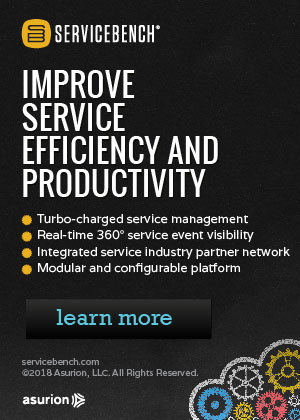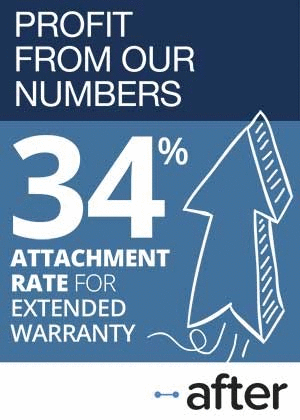Power Equipment Warranty Report: While the makers of electrical power generation equipment continue to adopt new storage technologies and new fuel sources such as solar and wind, the gap between the warranty expenses of the old and the new continues to narrow. But the makers of "green" and renewable energy equipment continue to set aside more money, just in case.
Whether it's an appliance, a car, or a television, manufacturers that make use of new technologies always seem to set aside a little extra money towards their warranty expenses, just in case costs turn out to be higher. And then, as the technology matures, and as the expense rates become known, they can make adjustments.
With electrical power equipment, however, that's not the way it's happening. Yes, over the past 14 years, the amount of claims paid by the makers of new types of equipment that use "green" sources of fuel such as sun and wind has gradually stabilized and even fallen, so that there is little difference now between the warranty expense rates of the old and new technologies. But no, the amount they're setting aside to prepare for future warranty expenses hasn't fallen as much. In fact, in some cases it's still rising.
We wanted to look at the warranty expenses of all the companies engaged in the business of providing equipment for the generation and storage of electrical power. The hard part about looking at that industry, however, is the fact that many of the top companies are diversified manufacturers in multiple industries besides electrical power equipment.
Diversified Manufacturers
For instance, Caterpillar Inc. is best-known as a construction equipment manufacturer, but it also makes diesel generators. So do Briggs & Stratton Corp., Cummins Inc., and Regal-Beloit Corp. But that's not what they're known for. So while we can't ignore them, if we include them we're measuring much more than just their warranty expenses related to electrical power equipment.
Similarly, Johnson Controls International makes car seats and HVAC systems, but it's also the world's largest manufacturer of automotive batteries. Terex Corp. manufactures all sorts of commercial vehicles, but it has an entire business segment dedicated to making vehicles and equipment just for electrical utilities. It's even beginning to make plug-in hybrid electric trucks for its utility customers to drive, which is about as circular a fuel source as there can be.
Furthermore, in the last few decades both the electrical power generation industry and the automotive industry have begin to turn away from traditional fuels such as oil, gas, and coal. Renewable energy sources such as solar, wind, biofuels, and hydro are slowly growing their market shares.
But even on the "green" side of the industry, most of the manufacturers are highly diversified. Few of the manufacturers are as much of a "pure play" as are First Solar Inc. or SunPower Corp. For instance, Applied Materials Inc. and Cypress Semiconductor Corp. come from the semiconductor industry. Babcock & Wilcox Enterprises is a leader in nuclear power plant construction as well as in biofuel energy technologies.
Meanwhile, Tesla Inc. is a passenger car manufacturer that uses electricity as fuel. That makes it more like an electrical appliance maker than a power equipment manufacturer. However, it dropped the "Motors" from its name to recognize its growing interests in solar panels and battery systems, not to forget its charging stations. But it's still primarily an automaker.
Even a diversified manufacturer such as Carlisle Companies, with operations in the aerospace, construction, and foodservice industries, also makes parts for wind turbines. AeroVironment Inc. makes drones for the Pentagon. Plus, it makes charging stations for electric vehicles, and calls itself the preferred charging partner for Nissan, Ford, Fiat, Mitsubishi, Kia, Volvo, and Hyundai.
And then there are some companies that are definitely in the electrical power generation industry, but they're on both the "traditional" side and the "green" side of the business. For instance, General Electric Co. has a deep involvement in the manufacture of electrical power grid infrastructure, from the power plants to the substations. But it also makes wind turbines, and claims to be one of the world's largest hydropower generation equipment manufacturers.
Split Into Two Groups
In total, we found 118 U.S.-based manufacturers with a significant presence in the electrical power generation equipment industry, which are reporting their warranty expenses in their financial statements. We're going to assign 47 of them to the "green" category, and the remaining 71 (including GE) to the "traditional" category.
In general, the green power equipment companies are younger and smaller than the traditional companies, but they're growing faster. In 2016, we found that the green companies grew their product sales by 21%, led by 60+ percent gains at SunPower and Tesla. In contrast, product sales by the traditional companies fell by 8% last year, with big declines at Johnson Controls, Terex, Caterpillar, and Cummins overwhelming sales gains at Carlisle Companies, Generac Holdings Inc., Briggs & Stratton, and a handful of others.
Besides product sales, we also gathered data from the financial statements of each company on the amount of warranty claims paid, the amount of accruals made, and the warranty reserve fund balance at the end of each year from 2003 to 2016. And using the sales data, we calculated two additional percentage rates, for claims as a percentage of sales, and for accruals as a percentage of sales.
In Figure 1, we're detailing the claims payments of the two groups for the past 14 years. Two things are obvious: first, the traditional side of the industry accounts for well over 90% of the warranty claims year after year, and second, the industry as a whole generated the highest volume of claims in 2008.
Figure 1
Worldwide Warranty Claims Paid
by U.S.-based Power Equipment Manufacturers
(in US$ millions, 2003-2016)
Keep in mind that companies such as GE and Caterpillar release only one set of worldwide figures for the warranty expenses generated by all their product lines. And given the reality of their product lines, it's highly unlikely that most of their warranty expenses arise from the manufacture of electrical power generation equipment. But without any data, any splits we might make would be nothing more than guesses.
Even on the green power side, we doubt that most of the $79 million in claims paid by Tesla last year came from sales of solar panels or batteries. But we are confident that most of the warranty expenses reported by SunPower, First Solar, and Enphase Energy Inc. were in fact related to the manufacture of electrical power generation equipment.
In all, the traditional side saw claims fall by $81 million last year, while claims rose by $20 million for the green power companies. But even together, they remain about $442 million below their 2008 peak.
Warranty Accruals
Warranty accruals were also down for the power equipment manufacturers last year. But once again, there was a split in the trend, with the traditional companies cutting accruals by $58 million and the green companies raising their accruals by $32 million. And with this metric the two groups together are also far below their 2008 peak, though for the green companies, at least, 2016 was a record year for accruals.
As can be seen in Figure 2, the traditional electrical power generation equipment manufacturers continue to account for the vast majority of the entire industry's accruals. However, in two of the past three years, their overall share slipped under 90%, which is due to the fact that the green technologies are generally newer and their warranty expense patterns less well-known.
Figure 2
Worldwide Warranty Accruals Made
by U.S.-based Power Equipment Manufacturers
(in US$ millions, 2003-2016)
GE raised its annual accruals by $142 million last year, while Tesla raised its accruals by $51 million. But those big increases were offset by large declines in accruals made by Cummins, SunPower, First Solar, Briggs & Stratton, Carlisle, and Valmont Industries Inc., among others.
Claims are backwards-looking, in the sense that they reflect the failure rates and the repair/replace costs of products sold in years past. But accruals are forward-looking, in the sense that they are made at the time a product is sold, based on the best estimates of future warranty costs. So when accruals rise or fall faster or slower than sales, it reflects a change in outlook.
For instance, at SunPower, product sales rose 65% last year, but the company cut its warranty accruals by $11 million. Claims were about the same -- up a little from 2015, but down a little from 2014. But, for the first time ever, the company's annual claims payments were larger than its accruals. In other words, the outlook has shifted towards an expectation of lower warranty costs in the future, now that the actual costs have more or less leveled off. The company expects to sell more product but does not expect warranty expenses to rise proportionately in the future.
Warranty Reserves
In general, the solar manufacturers in particular tend to make very conservative projections for their warranty costs. Most of them issue product warranties that can last from 10 to even 25 years, so it's wise to set aside more money for the future than is being spent currently on repairs and replacements. For instance, First Solar ended 2016 with a warranty reserve fund containing $252 million, even though it spent only $16.3 million in claims last year.
In contrast, GE spent $729 million on claims and kept a $1.92 billion warranty reserve fund. Cummins spent $385 million on claims and kept $1.41 billion on reserve. Caterpillar spent $909 million on claims and kept $1.26 billion in reserve. In other words, while First Solar had almost 16 times as much on reserve as was spent, these traditional manufacturers kept reserves at a much lower multiple.
This is the reason that the reserve totals detailed in Figure 3 are growing faster among the green companies. Last year, the green companies added $119 million to their total, while the traditional companies added $74 million. For the traditional companies, the increase was almost imperceptible, given the large amounts of money they already had on reserve in 2015. But for the green companies, it was their fourth straight year of growth, and their largest year-ending total ever.
Figure 3
Worldwide Warranty Reserves Held
by U.S.-based Power Equipment Manufacturers
(in US$ millions, 2003-2016)
Growth has been stronger for the green energy manufacturers for more than a decade. Back in the early years of warranty expense reporting, from 2003 to 2006, the greens' total was too small for us to even label. And on a relative basis, they barely accounted for 5% of the overall industry total.
However, their share continued to grow, and it finally surpassed 10% in 2013. It has never been less in the years since. In fact, the green companies set a record on their relative share of reserves in 2016, as they also did with accruals.
Warranty Expense Rates
Obviously, if accruals rise and claims level off, reserve balances will rise. And Figure 3 is a clear indication that this is what's happening for the green energy companies. Most of them have not changed their outlook, as SunPower has. They continue to accrue at a much higher rate than they are paying claims, leading to the buildup in reserves seen in Figure 3.
In Figures 4 and 5, we're going to take a closer look at these expense rates. Figure 4 compares the claims rates of the two groups, by dividing the claims totals detailed in Figure 1 by the corresponding sales totals. And Figure 5 compares the accrual rates of the two groups, by dividing the accruals totals of Figure 2 by sales.
Figure 4
U.S.-based Power Equipment Manufacturers
Average Warranty Claims Rates
(as a % of product sales, 2003-2016)
Note that in Figure 4, the green power equipment companies start off the period with much higher claims rates, beginning with a 3.2% rate in the first quarter of 2003. The traditional power equipment companies began the period with a claims rate almost two percentage points lower.
From 2003 until 2008, the greens saw their average claims rate gradually fall, to the point where in 2009 it was actually a bit lower than the average claims rate of the traditional power equipment companies. And it's generally been lower ever since, with the exception of the years 2012 and 2013, and a few quarters here and there.
Converging Claims Rates
In other words, there is no longer much of a gap between the average claims rates of the two groups. Since 2009 they have both remained relatively close to 1.2%, whether the power equipment is using solar, oil, wind, or coal as its fuel source. Over time, as the new technologies became more understood, their average claims rates converged with the long-term averages of the group using the traditional technologies.
However, because of the newness of the technologies involved, and the uncertainty of the customers regarding its longevity and reliability, the warranties issued for equipment using green fuel sources continue to be longer than for traditional fuel sources. And that has an impact upon expense rates as well. Even if the cost per year is the same, the products with more years will cost more.
That effect can be seen in Figure 5, which compares the accrual rates of the two groups. Here, unlike with Figure 4, the two lines rarely meet. In fact, of the 56 quarterly measurements in the chart, the average accrual rate of the green companies has been lower than the traditional companies only three times, and never since the middle of 2011.
Figure 5
U.S.-based Power Equipment Manufacturers
Average Warranty Accrual Rates
(as a % of product sales, 2003-2016)
Furthermore, despite the recent accrual rate cuts of SunPower, Tesla, and a few others, the average levels of the green group were significantly higher in 2015 and 2016 than they were between 2007 and 2014. In fact, they started 2015 with a slightly higher average accrual rate than they had at the beginning of 2003. The gap between the two industry sub-groups hit a record 1.5% in early 2015. And the gap continues to exceed half a percentage point even now.
The contrast couldn't be clearer. At the end of 2016, the green power equipment group had an average claims rate that was 0.3% lower than the traditional group's, yet their average accrual rate was 0.6% higher. So while their claims rates are now similar, the gaps between their accrual rates are actually higher than their long-term average.
| 













